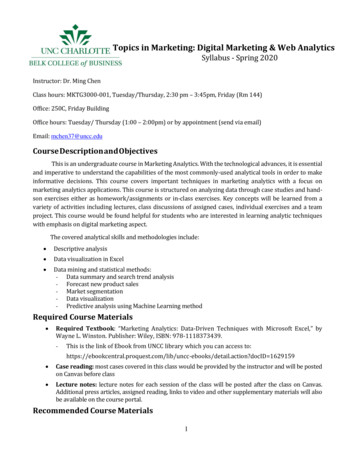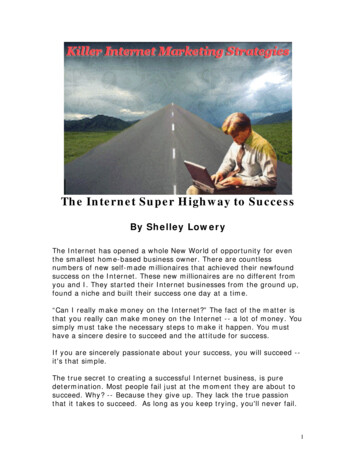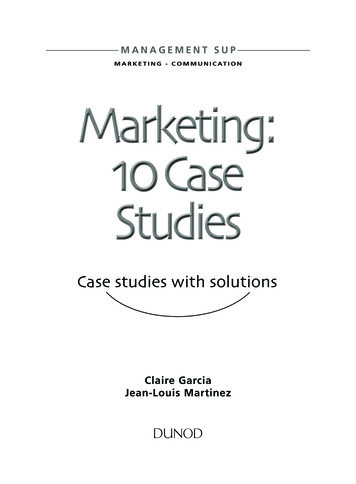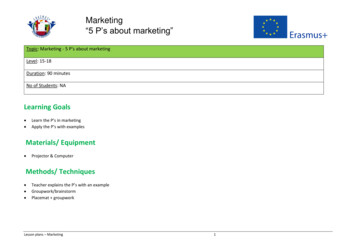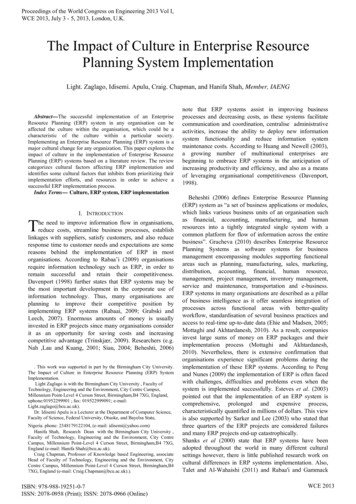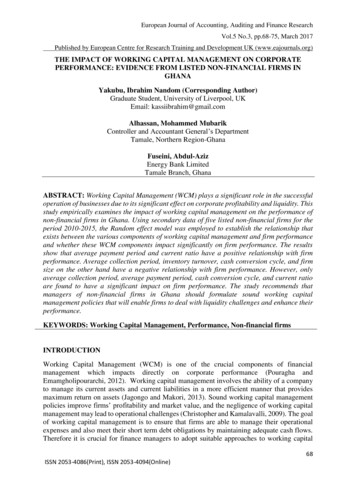
Transcription
Halmstad UniversitySchool of Business and EngineeringBachelor in Sciences of Business and EconomicsThe impact of marketing oncustomer’s behaviourInfluence or manipulation?Dissertation in Marketing, 15 higher education credits (ECTS)Wednesday, 1st of June 2011Authors: Group 06Sarah Correard, 891122Hayat El Amrani, 890321Supervisor: Jean-Charles LanguilaireExaminer: Timurs Umans
AcknowledgementFirstly, we would like to express our gratitude to the participants of the focus groupswho helped us to complete our thesis. Without their involvement and interest we willnot be able to understand this complex process.Secondly, we would like to give a warm thank to our supervisor Jean-CharlesLanguilaire who helped and encouraged us through all this process.
AbstractThe modern society is often criticized as being a society of consumerism. In fact, people areexposed and solicited by marketing everyday through diverse manners. One of the mostknown is advertising which became a part of people’s life. This leads to strong socialcriticism, in this thesis we focus on France. Since marketing is a part of people’s daily life, thepurpose of our thesis is to demonstrate how marketing is impacting on customer’sbehaviour.In order to understand how marketing is processing, we go through different theoreticalconcepts. Starting by defining influence and manipulation, we detail the customer throughhis/her needs, wants, demands, and the influencing factors. Then the role of marketing isexplained which leads to buying decision process.As the aim of this thesis is to understand a contemporary social process, a qualitativeresearch method combined with a case study design is chosen as the methodology. In thatregards, three focus groups have been conducted.The findings of the thesis are presented in the empirical material chapter, which brings to across-case synthesis between the two products chosen to answer our purpose: the Actimel,a dairy product and the iPad, an internet tablet. The differences and similarities arehighlighted regarding the theoretical concepts. In addition, the focus groups participants’perception of marketing is analysed. It appears that marketing is negatively perceived eventhough the participants of the focus groups are actually impacted by it. In fact, they criticizethe products presented but in the same time they find them interesting in some aspects.In conclusion, the possibility to influence or manipulate a customer depends on the ability ofthe marketer to use the right tools and his/her ethical considerations. Noticing that the maindifference between influence and manipulation is the intention behind.
Table of contentsAcknowledgement .Abstract.1 – Introduction . 11.1 – Background . 11.2 – Research problem. 21.3 – Purpose . 41.4 – Research questions . 41.5 – Structure . 42 – Theory . 52.1 – Influence & manipulation . 52.2 – Customer . 72.2.1Need – Want – Demand . 72.2.2Uncontrolled factors . 92.3 – Marketing . 122.3.1Product .132.3.2Price . 132.3.3Place . 132.3.4Promotion.142.4 – Buying process . 142.4.1Buyer decision process.142.4.2The different types of buying behaviour .162.4.3Buying roles .172.5 – Theoretical framework. 183 – Methodology and method . 193.1 – Methodology . 193.2 – Designing the case study. 203.3 – Collecting data. 223.3.1Secondary data .223.3.2Primary data .223.4 – Conducting the study in focus group . 233.5 – Reliability, validity and ethical considerations . 243.5.1Reliability and validity .243.5.2Ethical considerations .244 – Empirical material . 25
4.1 – Findings on Actimel . 254.2 – Findings on the iPad . 274.3 – Findings on marketing’s perception . 295 – Analysis . 335.1 – Influence and manipulation. 335.2 – Customer . 345.3 – Marketing . 345.3.1Product .345.3.2Price . 355.3.3Place . 355.3.4Promotion.355.3.5Marketing perception .365.4 – Buying process . 375.4.1Actimel .375.4.2iPad . 376 – Conclusion. 39References . aAppendices . iAppendix 1: iPad presentation by “Les Guignols de l’Info” . iAppendix 2: Original questionnaire in French translated by the authors . iiiAppendix 3 : Actimel’s advertisements . ivAppendix 4: iPad’s advertisement . v
The impact of marketing in customer’s behaviourInfluence or manipulation?1 IntroductionIn this chapter we start by explaining the concept of consumerism in the modern societyfollowed by the marketing process, its role and the social criticism mainly in France. Then wecontinue by the purpose of this thesis and the research questions. Finally, we present theentire structure of the thesis.1.1 BackgroundBaudrillard (1970), a French sociologist, describes people’s daily life as being governed byconsumption through a multiplication, an abundance of products. He characterizes thisphenomenon as being a society of consumer. Even if consumption is a part of human history(Smart, 2010) this “way of life in which having, desiring and wishing for more and morethings have become a significant preoccupation” (Smart, 2010, p.5) is described as a modernphenomenon: consumerism (Smart, 2010). According to Miller (2009), the tale of Aladdin,from the 1.001 Arabian Nights, is a useful metaphor for consumerism.“The Poor boy Aladdin discovers a magic lamp in a secret cave. When he rubs the lamp hereleases a terrifying but powerful Genius. [.] This genius of the Lamp grants Aladdin manywishes. [.] In the modern world, the market is the Genius, and its products embody ourwishes. [.] Through many cycles of market research, consumer feedback, and economiccompetition, the market, like the Genius, also makes enormous efforts to fulfil our statedwishes - but often, like the Genius, it obeys the letter rather than the spirit of those wisheswith frustrating consequences.” (Miller, 2009, p.19-20)The world of goods and services then reflects what people want or at least what they thinkthey want. Miller (2009) develops two categories of products:- Things that bring us satisfaction- Things that bring us “status” when others see that we own themThe last category shows that people can buy a certain kind of product because of how they“want to look” more that because they need it. Why would someone buy a Hummer H1Alpha (it is not practical, it is costly (139.771 ), uses a lot of gas and has a poor reliability) ifit were not an ornament? (Miller, 2009)Regarding this phenomenon, people are permanently solicited to buy goods and servicesthrough marketing strategies (Smart, 2010). Actually, marketing is nowadays unavoidable inpeople’s daily life. As a fact, we are exposed to 15.000 commercial stimuli every day createdby this field (Pêtre, 2007). One of the most known and recognised stimuli by people isadvertisement. Actually, people think too narrowly that “marketing is a pretentious term foradvertise” (Miller, 2009).Metaphorically, advertisement can be seen as the visible part of the marketing iceberg,which is part of our daily life. In point of fact, people are exposed to 350 advertisementsabove the promotion line and 1.200 to 2.200 below the promotion line. In another point offact, the worldwide advertisement spending is evaluated at 421 billion US Dollars (296, 8billion Euros) in 2009 (emarketer.com). To compare, the budget of France, fifth worldeconomic power, was 285, 23 billion Euros in 2010 (france.fr). So advertisement is allaround, an extreme example of how it can be present is people’s life is Times Square in NewYork (Figure 1.1). This street is famous because of its advertisement all along the buildings.Sarah Correard1Hayat El Amrani
The impact of marketing in customer’s behaviourInfluence or manipulation?Figure 1.1: Diez F. Times Square New York, USA, Web image, Guide VoyageRegarding those i
way for a company to manage this interaction and to achieve sales target and/or market share objectives (Kotler et al., 2008). More than just a communication, a relationship is created between the customer and the company to develop a right market offering, which is “some combination of products, services, information or experiences offered to a market to satisfy a need or a want” (Kotler .


